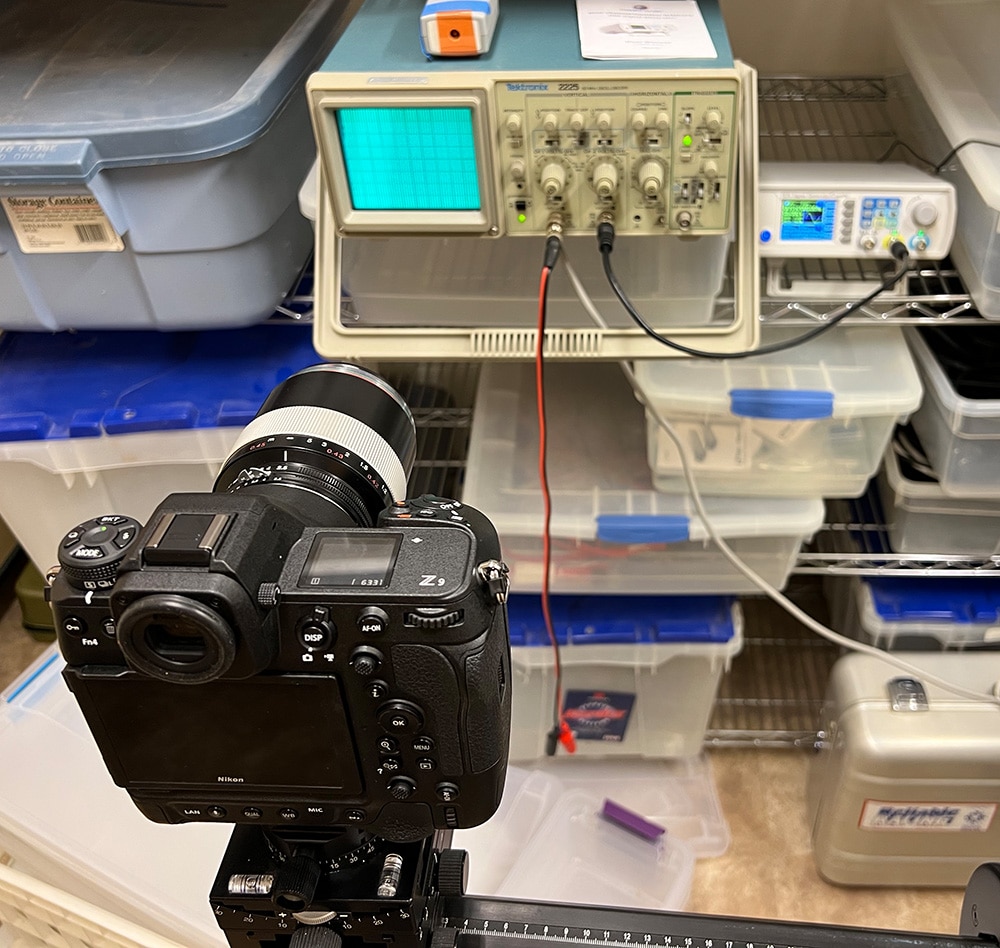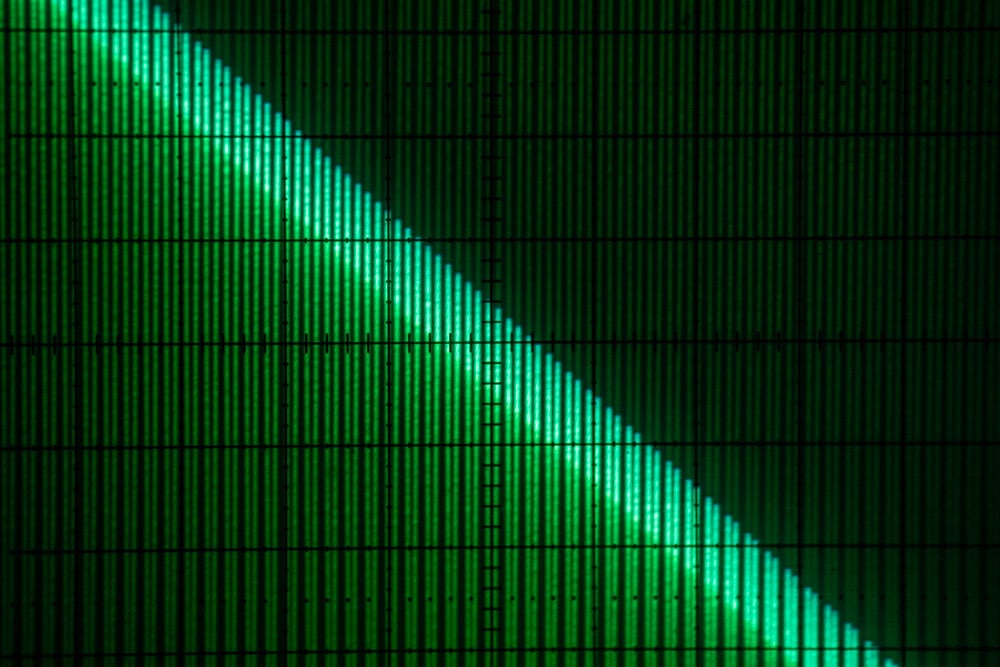This is one in a series of posts on the Nikon Z9. You should be able to find all the posts about that camera in the Category List on the right sidebar, below the Articles widget. There’s a drop-down menu there that you can use to get to all the posts in this series; just look for “Z9”.
To measure how fast focal plane shutters are, I use a setup like this:
What do we have here?
- Z9 on camera stand via a C1 cube
- ISO 2000
- Z9 set to 1/2000 second exposure
- CV 125/2.5 on Z9
- Lens set to f/2.5
- Analog oscilloscope, sweep speed 0.5 milliseconds per division
- Function generator set to produce a 10 KHz triangle wave
Here’s the picture the camera took:
The bright green traces are the ones to look at. The dimmer green traces are due to phosphor persistence in the scope. The width of the green band is about one division. One division is 500 microseconds. 1/2000 second is 500 microseconds. Earlier time is on the left, and later time is on the right. So the shutter exposes the sensor from the top of the image to the bottom. That’s the same as saying the shutter exposes the sensor from the bottom of the sensor to the top. That is the way that Sony MILCs have done things, but is the opposite of the traditional Nikon shutter direction.
It takes 7.4 divisions for the start — and the end — of the exposure to travel from the top of the image to the bottom. That means it takes 3.7 milliseconds for that to happen. 3.7 milliseconds is 1/270 second.
Pretty fast for a FF electronic shutter.


Is the Z9 a good landscape camera or is the D850 better
If you are strictly concerned with dynamic range at base ISO, the D850 is your camera. However, the Z9 is much easier to focus manually. I’d take the Z9.
So with this kind of sensor readout speed, can we assume Z9 is able to take 8k video at 120 fps?
It cannot do that.
The blazing fast readout speed of 3.7ms in stills mode is achieved by utilising DRAM, which does not function in video mode. The ADC has to continuously operate and output data in video mode and it’s limited by thermal and power constraint.
Hi Jim
Based on your tests, do you think the Z9 sensor is based on Sony A1 or it is different in some fundamental ways that would indicate it is not a Sony sensor.
I don’t know. It has a lot in common with recent Sony sensors.
Out of interest if you rant this test at the fastest shutter speed of 1/32000th second what would it show?
Same transit time. Thinner band. Dimmer image.
hi – thanks for the response, but it simply does not sound right. How can the whole sensor be scanned in 1/32,000 second – so 0.03125 milli seconds and yet the transit time sty at 1/250 — surely the transit time must vary to reflect the shutter speed. What about if you ran your test at 1/50, 1/500, and 1/5000 second – I would expect the slope shown on your chart to be much flatter, flatter and much steeper than your example.
Or maybe I simply do not understand your chart -I had assume your chart shows readings the whole of the sensor or a vertical slice.
The image posted is a photograph of a time-varying subject. It does include the whole of the sensor, but reflects what the camera is recording at various times, starting on the left side of the image, and getting later on the right.
I think you have a fundamental misunderstanding of how a focal place shutter — electronic or mechanical — works. It doesn’t expose the whole sensor at exactly the same time. There are two — electronic or mechanical — curtains. They both travel in the same direction, usually from top to bottom or bottom to top of the image when the camera is in landscape orientation. The first one proceeds across the sensor at some more-or-less constant rate. The time it takes to get to the other side is called the transit time — it’s the time the shutter takes to traverse the sensor. The second curtain starts after the first one, delayed by the amount of time determined by the shutter speed. If the shutter speed is set to 1 second, the second curtain starts 1 second later. If the time is set to 1/1000 second, the second curtain starts 1 millisecond later. If the shutter speed is long, then there are times when the whole sensor is exposed to light. If the shutter speeds are shorter than the transit time, a slit passes over the shutter. At 1/32000 second, it’s a very narrow slit.
I once had a camera, a 4×5 Speed Graphic, which allowed the user to vary the transit time of the shutter. I’ve never seen a 35 mm or medium format camera that allowed that, except by changing shutter modes. The Z9 has no mechanical shutter, and thus doesn’t allow the user to change the transit time.
Hi
do you know what the Shutter lag is for the Z9. The D850 was about 57ms, is the Z9 faster?
I think I read that once the first image is taken the shutter lag is about 7ms?
great post
The Z9 should have less shutter latency than the D850, but I haven’t measured it.
Hi Jim, was this 14 bit or 12 bit readout speed?
I’m sorry I didn’t note that. 14 bit precision.
Hello Mr. Kasson,
you did some impressive mesurements. Today i did some first test: Some lightbarrier should trigger the flash and the Z9 independently. Z9 is setup manually, no AF, standby time is increased, Series or Single mode , exposure time about 1/10 in M mode, Silent mode and so on to be as fast as possible. I added some delay in the flash trigger path beware of the shutter lag. To my surprise the flash is only partial visible on the picture after about 40ms and reliable after 50ms. So my question, did you make the same experience? Can the shutter lag be reduced by another setting?
Thank you in advance
Christian
That seems a little long to me, although I didn’t test shutter latency on the camera. What’s the flash delay?
I just did some measurements from camera input trigger to Flash X-Sync Pin (need some high value pullup resistor to camera 5V Pin nearby), Shutter delay is really in the range from 48-57ms with FTZ adaptor + 105mm Nikon Micro VR G mount (quite slow, i am dissapointed). It can not be reduced by any other camera setting. About 10ms can be saved by using some old lenses with preadjusted manual aperture rings, but some extra Z Mount adaptor is needed for this. The FTZ adaptor does not seem to support this mode (FEE error). Flash delay is in the range of about 120us for Yongnuo 685. So the Z9 is the limiting factor.